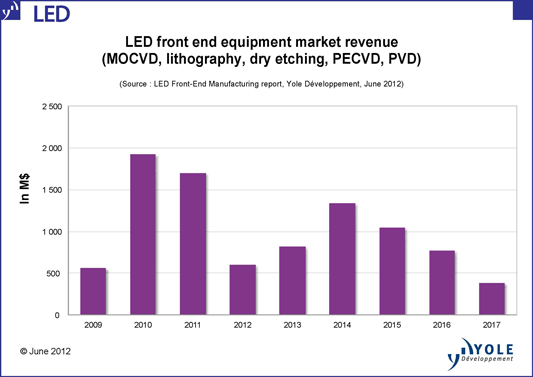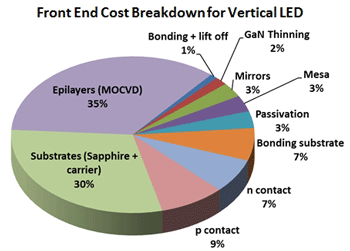- News
4 July 2012
LED front‐end equipment market to see turbulent investment cycles
Market research firm Yole Développement and EPIC have announced the report ‘LED Front‐End Manufacturing’ (to be published on 16 July), dedicated to the market for LED manufacturing technology & equipment, including MOCVD, lithography, plasma etching, PECVD and PVD tools. The report comments that, despite expectations that the packaged LED market will saturate in value by the end of the decade, it still presents significant opportunities for growth in the next five years.
Gearing up for the next investment cycle
Led by metal-organic chemical vapour deposition (MOCVD) reactors, the LED front-end equipment market experienced an unprecedented investment cycle in 2010-2011. The cycle was driven by demand in LCD backlight displays, anticipation of the general lighting market, and generous subsidies offered by the Chinese central and local governments in a bid to generate domestic chip production firms. However, this has resulted in a significant overcapacity situation that will take 12-18 months to absorb. The next investment cycle (driven by lighting applications) is expected to start in 2013 and to be more limited in value than the previous cycle due to improvements in equipment throughput and yields. The MOCVD equipment market represents a $4.3bn opportunity in the 2012-2017 period.

Together, tools for lithography, plasma etching, PECVD (plasma-enchanced CVD) and PVD (physical vapour deposition) represent a $650m opportunity and will essentially follow a similar trend, with some exceptions, says Yole.
The market for dry etching tools is still growing in 2012 due to the increasing adoption of patterned sapphire substrates (PSS). However, the market for most lithography tools will decline as the industry transitions to larger-diameter substrates and the number of wafer starts initially increases moderately but starts decreasing in 2015, says Eric Virey, senior analyst, LED, at Yole.
PVD equipment will also experience moderate growth during the next investment cycle. Electron-beam evaporators have turned into commodities, with systems available from dozens of vendors at very low cost. But opportunities exist in promoting sputtering for indium tin oxide (ITO) deposition, and sputtering could also gain some traction in metal deposition if the industry adopts large-diameter wafers and moves from batch processing to single-wafer processing. Sputtering equipment could then offer improved cost of ownership, says Yole.
Learning from the semiconductor industry
With nearly 100 firms involved in front-end LED manufacturing, the industry is too fragmented to generate significant economies of scale, reckons Yole. “We expect massive consolidation within the next three years (2012-2015), which should eventually speed up process and tool standardization and allow economy of scale,” says Virey.
LED manufacturing still uses methods that would be considered outdated in most semiconductor industries. Consolidation and the emergence of LED ‘giants’ will also facilitate and speed up the adoption of manufacturing paradigms from the IC industry, expects Yole.
The adoption of silicon substrates for LED manufacturing could speed up those trends by rapidly moving LED epiwafer processing into existing, highly automated and fully depreciated CMOS fabs. This would also give LED makers access to extended ‘process toolboxes’, which could pave the way for entirely new LED structures, reckons Yole.
MOCVD still a key element for manufacturing cost reduction
To enable massive adoption in general lighting applications, significant technology and manufacturing efficiency improvements are still needed to reduce the cost per lumen of packaged LED, says the market research firm. Front-end LED manufacturing typically represents about 50% of the total cost of a packaged LED and offers significant opportunities. Continuous progress is being made in terms of LED structures and materials to improve performance, manufacturability or reduce cost.
While MOCVD represents the single largest opportunity for front-end cost reduction, downstream the emergence of LED-dedicated tools has already contributed significantly to cost reduction in lithography, plasma and PVD processing, notes Yole.
 Traditional large semiconductor equipment suppliers are mostly absent from LED manufacturing equipment markets. MOCVD tools are very different to epitaxy tools used in mainstream semiconductor manufacturing. Designing and building such equipment requires significant and unique expertise that the leading MOCVD system makers Aixtron, Veeco and Taiyo Nippon Sanso have acquired over almost two decades, remarks Yole.
Traditional large semiconductor equipment suppliers are mostly absent from LED manufacturing equipment markets. MOCVD tools are very different to epitaxy tools used in mainstream semiconductor manufacturing. Designing and building such equipment requires significant and unique expertise that the leading MOCVD system makers Aixtron, Veeco and Taiyo Nippon Sanso have acquired over almost two decades, remarks Yole.
Other front-end LED manufacturing tools are similar in essence to those used in mainstream semiconductor. However, in order to deliver optimum performance and cost of ownership (COO) for LEDs they often require a full re-design, notes Yole. This has opened the door to smaller companies eager to capture the opportunity offered by this niche market, and those companies are now offering LED-dedicated tools delivering significant COO improvements, the firm adds.
IMS cuts 2012 MOCVD shipment forecast from 342 systems to 281
MOCVD system shipments for GaN LEDs to fall 48% to 342 in 2012
www.i-micronews.com/reports/LED-Front-End-Manufacturing/3/298
